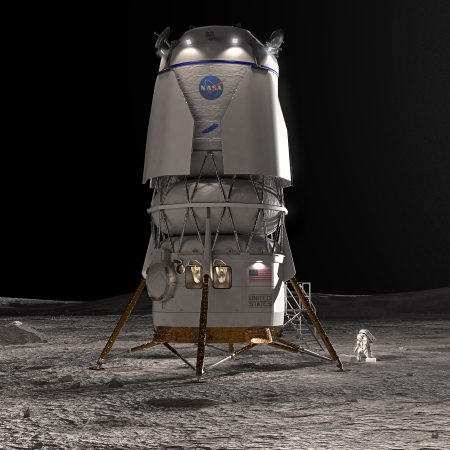First two stages of New Glenn assembled for the first time
After years of delays, Blue Origin announced yesterday that it has finally joined the first and second stages of its orbital New Glenn rocket, in preparation for its planned first launch later this year.
The stages remain horizontal inside Blue Origin’s assembly facility at Cape Canaveral, where engineers continue to check them out.
New Glenn’s launch was originally supposed to be in 2020. Problems with its first stage BE-4 engine put it (as well as ULA’s Vulcan rocket) four years behind schedule. The evidence now suggests that those problems were badly acerbated by the poor leadership of Bob Smith, Blue Origin’s CEO from 2017 to 2023, who apparently refused to spend money on test engines and the additional hardware necessary to test the engine to figure out what was wrong. Smith also appeared to slow all other work down in numerous ways as well as antagonize many at the company, causing a lot of high level engineers over time to flee.
Almost to the day Smith left last year Blue Origin has appeared to come to life. If so, this bodes well for both its future as well as that of the entire American rocket industry. New Glenn is a very powerful rocket, capable of lifting 50 tons to low Earth orbit, making it comparable to SpaceX’s Falcon Heavy. Its first stage is also designed to be reuseable, landing on a drone ship like the Falcon 9. If successful it will thus be a very capable competitor to SpaceX.
The company is aiming for an August launch. Keep your fingers crossed.
After years of delays, Blue Origin announced yesterday that it has finally joined the first and second stages of its orbital New Glenn rocket, in preparation for its planned first launch later this year.
The stages remain horizontal inside Blue Origin’s assembly facility at Cape Canaveral, where engineers continue to check them out.
New Glenn’s launch was originally supposed to be in 2020. Problems with its first stage BE-4 engine put it (as well as ULA’s Vulcan rocket) four years behind schedule. The evidence now suggests that those problems were badly acerbated by the poor leadership of Bob Smith, Blue Origin’s CEO from 2017 to 2023, who apparently refused to spend money on test engines and the additional hardware necessary to test the engine to figure out what was wrong. Smith also appeared to slow all other work down in numerous ways as well as antagonize many at the company, causing a lot of high level engineers over time to flee.
Almost to the day Smith left last year Blue Origin has appeared to come to life. If so, this bodes well for both its future as well as that of the entire American rocket industry. New Glenn is a very powerful rocket, capable of lifting 50 tons to low Earth orbit, making it comparable to SpaceX’s Falcon Heavy. Its first stage is also designed to be reuseable, landing on a drone ship like the Falcon 9. If successful it will thus be a very capable competitor to SpaceX.
The company is aiming for an August launch. Keep your fingers crossed.

